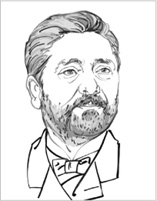

If there is one thing you need to know as a manager, it is the fact that innovations are never welcomed with open arms. Accordingly, whenever you innovate, you will always find yourself facing an uphill struggle. The Eiffel Tower serves as a good example because if many prominent Parisians had had their way back in 1887 it would never have been built.
Gustave Eiffel (1832–1923) had already made a name for himself around the world by constructing steel bridges, various facilities, and exhibition pavilions. His most famous buildings include the first department store built of steel and glass, Le Bon Marché, in Paris (1876), designs for locks along the Panama Canal (1882–1914), and the armature for the Statue of Liberty in New York (1886). The idea of erecting a tower came to Eiffel when he was constructing metal bridge piers. The first designs date from 1884 and can be attributed to Eiffel’s colleague Maurice Koechlin.
Eiffel’s firm of architects won the competition launched in 1886 to develop the site for the Paris World Expo in 1889 by erecting a tower on the Champ de Mars as a kind of trademark of the exhibition. After over two years of work directed by Koechlin, the structure that has become the most famous Parisian landmark was completed. Full of joyful enthusiasm, Gustave Eiffel proclaimed: “France will be the only country in the world with a 300-meter flagpole.”1
But rather than receiving a universally warm welcome, the plan for Eiffel’s innovative structure unleashed a storm of protests. Indeed, leading lights like the composer Charles Gounod, the authors Émile Zola, Leconte de Lisle, Guy de Maupassant, and Alexandre Dumas, and Charles Garnier, the architect of the Paris Opera House, drew up a petition that proclaimed: “We, the writers, painters, sculptors, architects and lovers of the beauty of Paris, do protest with all our vigor and all our indignation, in the name of French taste and endangered French art and history, against the useless and monstrous Eiffel Tower.”2
But once the tower had been completed, those initial misgivings soon turned to jubilation, and the structure was duly featured on paintings by Pissarro, Dufy, Utrillo, Seurat, Marquet, and Delaunay and was mentioned in poems by Apollinaire and Cocteau. And who today could imagine Paris without the Eiffel Tower?
As the manager of an organization, you should not necessarily expect such a dramatic switch from initial opposition to euphoric acceptance of your plans. In fact, you would be wrong to expect your innovative ideas to be met with joy, for quite the opposite is the norm. Spotting promising opportunities and seizing them for your organization is psychologically demanding: often it means abandoning old habits. Worse still, it frequently involves letting go of the very things that the organization’s most capable people hold most dear. It takes unremitting efforts to overcome their opposition, strike a balance between clashing interests, and thus ensure that the innovation is successfully carried through to completion. What any innovation needs is someone who says “I will make a success of this” and then sets to work and does not stop until the intended breakthrough has been achieved.
Anything that has been improved or that is new needs to be tested—on a small scale. This would have been difficult with something like the Eiffel Tower, yet the general rule still applies: market research, studies, and simulations are no replacement for real-life testing. Pilot tests are essential.
The key is to ensure that the best and most deeply respected people take up the challenge. Whoever is placed in charge must not be selected merely because he or she has the time. Indeed, it is likely that people with time on their hands will not be the right choice. Furthermore, the person in question does not necessarily need to come from within your organization. In many cases a good solution is to work with a customer who really wants a new product or service, is prepared to work as part of a team to establish it, and is also willing to persevere until all the inevitable problems have been overcome. If the ensuing pilot test proves successful, the risks run by going ahead with the planned innovation will usually be relatively minor.
![]() Make sure that your best ideas are driven forward by really good people.
Make sure that your best ideas are driven forward by really good people.
![]() Which innovative projects should you start working on tomorrow, despite all the difficulties that are bound to crop up?
Which innovative projects should you start working on tomorrow, despite all the difficulties that are bound to crop up?